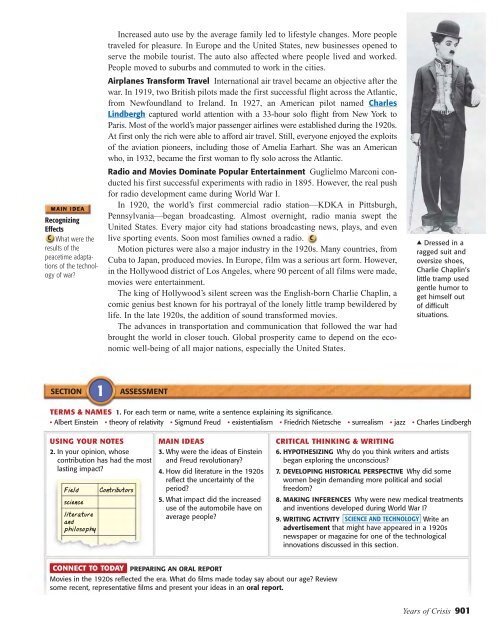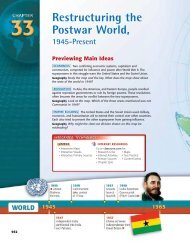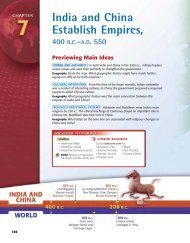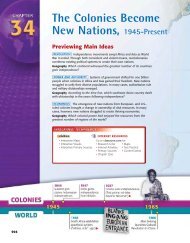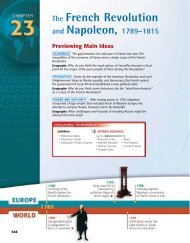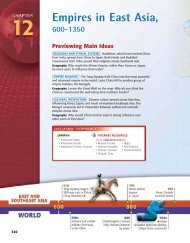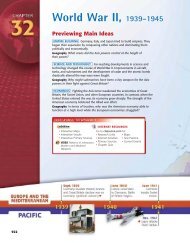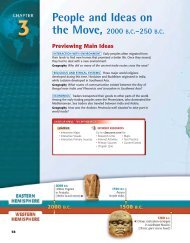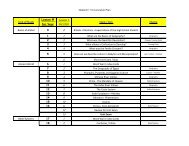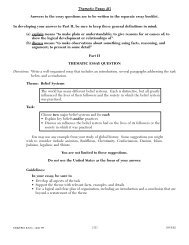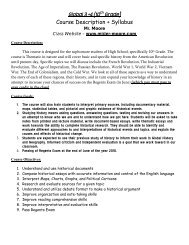Years of Crisis, 1919–1939 - Mister Moore
Years of Crisis, 1919–1939 - Mister Moore
Years of Crisis, 1919–1939 - Mister Moore
You also want an ePaper? Increase the reach of your titles
YUMPU automatically turns print PDFs into web optimized ePapers that Google loves.
Recognizing<br />
Effects<br />
What were the<br />
results <strong>of</strong> the<br />
peacetime adaptations<br />
<strong>of</strong> the technology<br />
<strong>of</strong> war?<br />
Increased auto use by the average family led to lifestyle changes. More people<br />
traveled for pleasure. In Europe and the United States, new businesses opened to<br />
serve the mobile tourist. The auto also affected where people lived and worked.<br />
People moved to suburbs and commuted to work in the cities.<br />
Airplanes Transform Travel International air travel became an objective after the<br />
war. In 1919, two British pilots made the first successful flight across the Atlantic,<br />
from Newfoundland to Ireland. In 1927, an American pilot named Charles<br />
Lindbergh captured world attention with a 33-hour solo flight from New York to<br />
Paris. Most <strong>of</strong> the world’s major passenger airlines were established during the 1920s.<br />
At first only the rich were able to afford air travel. Still, everyone enjoyed the exploits<br />
<strong>of</strong> the aviation pioneers, including those <strong>of</strong> Amelia Earhart. She was an American<br />
who, in 1932, became the first woman to fly solo across the Atlantic.<br />
Radio and Movies Dominate Popular Entertainment Guglielmo Marconi conducted<br />
his first successful experiments with radio in 1895. However, the real push<br />
for radio development came during World War I.<br />
In 1920, the world’s first commercial radio station—KDKA in Pittsburgh,<br />
Pennsylvania—began broadcasting. Almost overnight, radio mania swept the<br />
United States. Every major city had stations broadcasting news, plays, and even<br />
live sporting events. Soon most families owned a radio.<br />
Motion pictures were also a major industry in the 1920s. Many countries, from<br />
Cuba to Japan, produced movies. In Europe, film was a serious art form. However,<br />
in the Hollywood district <strong>of</strong> Los Angeles, where 90 percent <strong>of</strong> all films were made,<br />
movies were entertainment.<br />
The king <strong>of</strong> Hollywood’s silent screen was the English-born Charlie Chaplin, a<br />
comic genius best known for his portrayal <strong>of</strong> the lonely little tramp bewildered by<br />
life. In the late 1920s, the addition <strong>of</strong> sound transformed movies.<br />
The advances in transportation and communication that followed the war had<br />
brought the world in closer touch. Global prosperity came to depend on the economic<br />
well-being <strong>of</strong> all major nations, especially the United States.<br />
SECTION 1 ASSESSMENT<br />
TERMS & NAMES 1. For each term or name, write a sentence explaining its significance.<br />
• Albert Einstein • theory <strong>of</strong> relativity • Sigmund Freud • existentialism • Friedrich Nietzsche • surrealism • jazz • Charles Lindbergh<br />
USING YOUR NOTES MAIN IDEAS<br />
2. In your opinion, whose 3. Why were the ideas <strong>of</strong> Einstein<br />
contribution has had the most and Freud revolutionary?<br />
lasting impact?<br />
4. How did literature in the 1920s<br />
reflect the uncertainty <strong>of</strong> the<br />
Field Contributors period?<br />
science<br />
5. What impact did the increased<br />
use <strong>of</strong> the automobile have on<br />
literature<br />
and<br />
philosophy<br />
average people?<br />
CONNECT TO TODAY PREPARING AN ORAL REPORT<br />
Movies in the 1920s reflected the era. What do films made today say about our age? Review<br />
some recent, representative films and present your ideas in an oral report.<br />
▲ Dressed in a<br />
ragged suit and<br />
oversize shoes,<br />
Charlie Chaplin’s<br />
little tramp used<br />
gentle humor to<br />
get himself out<br />
<strong>of</strong> difficult<br />
situations.<br />
CRITICAL THINKING & WRITING<br />
6. HYPOTHESIZING Why do you think writers and artists<br />
began exploring the unconscious?<br />
7. DEVELOPING HISTORICAL PERSPECTIVE Why did some<br />
women begin demanding more political and social<br />
freedom?<br />
8. MAKING INFERENCES Why were new medical treatments<br />
and inventions developed during World War I?<br />
9. WRITING ACTIVITY SCIENCE AND TECHNOLOGY Write an<br />
advertisement that might have appeared in a 1920s<br />
newspaper or magazine for one <strong>of</strong> the technological<br />
innovations discussed in this section.<br />
<strong>Years</strong> <strong>of</strong> <strong>Crisis</strong> 901


